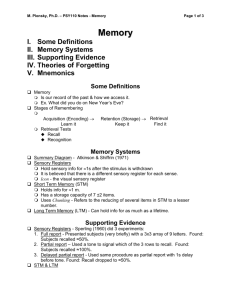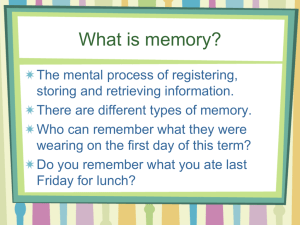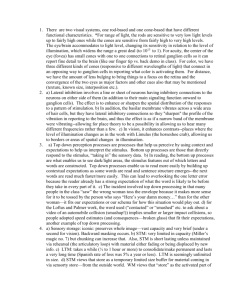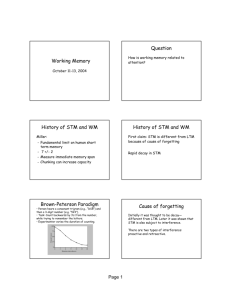Powerpoint
advertisement
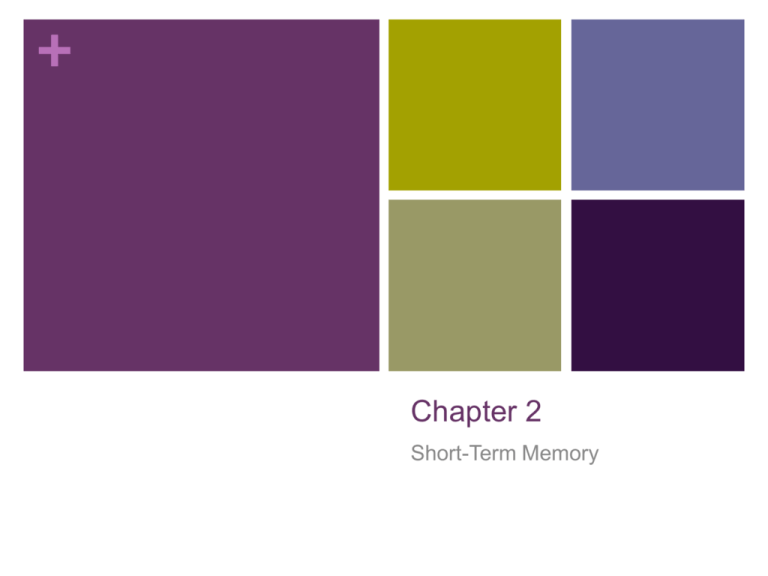
+ Chapter 2 Short-Term Memory + Short-Term Memory and Working Memory What is the Difference? Short-Term Memory (STM): A store containing small amounts of information over brief intervals, tested either immediately or after a short delay. STM is part of Working Memory (WM) Often tested by digit span (Jacobs, 1887) Working Memory (WM): A system for the temporary storage and manipulation of information to allow for reasoning, learning, and comprehension. All theories of WM assume that complex reasoning & learning tasks require a mental workspace to hold and manipulate information Often tested by working memory span, a more complex task. + Digit Span Test your digit span Read each sequence as if it were a telephone number, then close your eyes and try to repeat it back. Start with the four digit numbers, and continue until you fail on both sequences at a given length. Your span is one digit less than this. + Memory Span Capacity Digit span is limited to about six to seven digits for most people Some recall as few as four or as many as ten plus Though classically tested with digits, other stimuli (e.g. letters or words) can be used to assess memory span changing the difficulty of the task. Memory span depends on two abilities: Remembering what the items are – this is trivial (easy) for familiar English digits but would be harder for Finnish. Remembering the order of the items. + How is Order Remembered? Chaining Item Item Item Item Item Item #1 #2 #3 #4 #5 #6 Chaining: One possible method of remembering the order of the items in which each item is linked to the next in the series. Chaining predicts that if the chain is broken, no further items can be recalled. In reality, despite an increase of errors after one mistake, forgetting a link is not as catastrophic as chaining predicts. + Which sequence is easier to repeat back? CTAIILTCSFRO FRACTOLISTIC Both chains have the same letters in them but one is harder than the other. This string of letters can be broken into syllables which are remembered in “chunks” + Memory Span Chunking RATSHOELET RAT SHOE LET + Memory Span Chunking George Miller suggested that memory span is limited to a certain number of chunks Chunking -- Grouping a series of random items into a smaller number of meaningful segments to enhance recall, often related to language patterns. Chunking can also be based on the prosody (rhythm) of the presentation list, like the alphabet. Random digits are best chunked into groups of about three items, like telephone numbers xxx-xxxx or social security numbers xxx-xx-xxxx. + Memory Span Errors Short-term memory for consonants appears to rely partially on an acoustic code, even when the letters are presented visually (Conrad, 1964) As the acoustic (sound-based) information rapidly fades, errors reveal how the items are processed. Items become confused when they include consonants with a similar sound (e.g. P vs V), instead of those with a similar visual form (P vs R). Memory is better for lists of consonants with dissimilar sounds – so CVDPGT vs KRXLYF is easier than PTCVBT. + Interference versus Trace Decay Distractor Task Study: XRQ Count Backwards by 3 from: 49 Recall: XRQ In a Peterson task, a distractor task is introduced following a study item, impairing memory for the original study item. This happens even when the distractor task is unrelated to the study list (e.g. involves numbers not letters) – unlike interference in LTM. + Similar Results for Trigrams and Word Triplets. The Petersons concluded that short-term memory traces decay as a function of time (simple trace decay) not because of interference from the distractor task (involving numbers). Interference Builds Up Over Trials Study: CAT Count Backwards by 3 from: 49 Trial #2 Trial #1 + Study: DOG Recall: CAT Count Backwards by 3 from: 26 Recall: DOG From Loess (1968). Copyright © Elsevier. Reproduced with permission. The idea of trace decay does not explain observed changes in forgetting over multiple trials: Forgetting is nonexistent on early trials but builds up over several trials using similar items. This suggests the effect is caused by interference from previous trials, because of the similarity to the later ones + Testing the Interference Theory Supporting the interference perspective, recall declines with increasing numbers of trials involving items from the same category, such as “kinds of pets” but rebounds when the category changes to “names of colors.” Category Shifts The spikes show release from interference whenever the category changes. 4 categories = items drawn from 4 kinds of items presented in random order Same category = a series of items all from the same category From Loess (1968). Copyright © Elsevier. Reproduced with permission. + Free Recall Task Free Recall Paradigm Free Recall Results Popularized in the 1960s Involves asking participants to recall a list of studied items in any order Serial Position Curve Recency Recency Primacy Recency From Postman and Phillips (1965). Copyright © Psychology Press Recall probability for a given item declines as list length increases The absolute number of items recalled increases with list length Primacy effect: The first few items on a list are more likely to be recalled Recency effect: The last few items on a list are very well recalled The recency effect is eliminated by a brief delay filled with a distractor task + Primacy Effect and LTM The primacy effect depends principally on long-term memory (LTM) It occurs because there is a tendency to rehearse the first few items during their initial presentation and throughout the remainder of the study list. Rehearsed items have a better chance of being stored in LTM, making them available for later recall. + Factors Influencing Primacy We conclude that LTM explains the primacy effect because the factors affecting LTM also affect primacy but not recency. These include: Presentation rate: Slower presentation enhances ability to recall items. Word frequency: More frequently encountered (familiar) words are easier to recall. Imageability: Words that are easier to visualize are easier to recall (concrete vs abstract words). Age: Younger adults remember more than children/elderly. Physiological state: Drugs such as marijuana and alcohol impair memory performance. + The Recency Effect Serial position curves for lists of 10, 20, or 30 words recalled immediately or after a 15-second delay. Note that the recency effect disappears when there is a delay in testing. From Postman and Phillips (1965). + Why a Recency Effect? Early interpretations (from the 1960’s) suggested that STM is a qualitatively different kind of memory store than LTM: Recency, unlike primacy, relies upon the output of a temporary short-term store. If this is true, a short distractor task (delay) following the study list should disrupt the shortterm store, eliminating the recency effect. It does. Study list: Short-term store: CAT DOG • CAT…CAT…CAT... CAT… PIG • CAT…DOG…CAT…D OG… BUG • CAT... DOG… PIG… CAT… 35+17=? • CAT… DOG… PIG… BUG… + Problems with the Idea of a Short Term Memory Store While a short distractor task after the entire list does wipe out the recency effect, presenting the same distractor task after each and every item in the list brings back the recency effect. This shouldn’t happen if recency depends on STM. Recency effects arise for LTM too, even at extensive intervals (months later), long after items can be assumed to have fallen out of any short-term store. Remembering where you parked last, for example. This has been called long-term recency. CAT 22+15=? • CAT…CAT…CA T... CAT… DOG • CAT…DOG…C AT…DOG… 43+18=? PIG 11+96=? • CAT... DOG… PIG… CAT… BUG 35+17=? • CAT… DOG… PIG… BUG… + Long-Term Recency Baddeley and Hitch’s (1977) Rugby Study Question: “Which teams have you played this past season?” Results: Recency effect: Recent games were recalled best. The total number of games played, not the amount of time gone by, best predicted forgetting. + Explaining the Recency and the Peterson Effects The idea of a special STM with its own properties has been abandoned in favor of the idea that recency effects occur because there is a particular retrieval strategy involved. This retrieval strategy appears to be based on the discrimination ratio (the distance in time between an item and its nearest competitor). Crowder’s (1976) telephone post metaphor – the apparent distance between telephone poles is greatest for those you have just passed, making them more discriminable (easier to tell apart and thus recall). + Verbal Short-Term Memory By the end of the 1960s, evidence suggested STM was not a unitary system, but involved a number of interacting systems. and Hitch’s (1974) multi-component model of working memory proposed, among other things: Baddeley A phonological loop, with two subcomponents: A short-term store: Limited in capacity; items decay within a few seconds unless rehearsed (just like STM) An articulatory rehearsal process: Saying the word to oneself aloud or subvocally refreshes the memory traces in the short-term store + Phonological Similarity Effect Phonological Similarity Effect: Memory span is greatly reduced for similar sounding items, much more than it is for lists with similar meanings. List 1 (Easy to remember/dissimilar phonology and semantics): PIT, DAY, COW, PEN, HOT List 2 (Only slightly harder than List #1/similar semantics) : HUGE, WIDE, BIG, LONG, TALL List 3 (Much harder than List #1/similar phonology) : CAT, MAP, MAN, CAP, MAD When the task relies on LTM (e.g. longer lists with several learning trials), semantic similarity becomes much more important than phonological similarity. + Baddeley’s Results The effect of phonological and semantic similarity on immediate serial recall of five-word sequences. Phonological similarity leads to poor immediate recall whereas similarity of meaning has little effect. From Baddeley (1966a). List A in this figure is like List 3 on the preceding slide, where words sound similar but mean different things. List C is like List 2 where words have similar meanings. List B is like List 1. When information is read out from the phonological store, items that share phonological features are more likely to be confused + Explaining the Phonological Similarity Effect What enters the phonological store? Auditory speech is automatically fed into the phonological store Nameable, visually presented items (e.g. digits, letters, or objects) are typically fed into the phonological store as well, through a process called articulation . Items can be blocked by repeatedly saying aloud or subvocalizing an unrelated word (a process called articulatory suppression). Articulatory suppression eliminates the phonological similarity effect for visually presented items. It also reduces overall recall, so we know that articulation must be important to memory. + Word-Length Effect Word-length effect: Recall decreases as the length of time it takes to say a word increases. Rule of thumb: People can remember about as many words as they can say in 2 seconds. Why? It takes longer to say longer words when rehearsing them, so more forgetting will occur because more time has passed. It also takes longer to recall lengthy words on the final test, compounding the delay (more forgetting during recall too). Articulatory suppression eliminates the word-length effect for both spoken and visually presented items because it blocks rehearsal of both item types. Memory also decreases. + Word-Length Effect The relationship between word length, reading rate, and recall. Long words take longer to rehearse and also produce lower memory spans. From Baddeley, Thomson, and Buchanan (1975). Copyright © Elsevier. Reproduced with permission. + Word-Length Effect Three Alternative Explanations The explanation for the word-length effect remains controversial. Trace decay: Baddely’s theory. Interference: Longer words are more complex, leading to greater interference and forgetting. Fragmentation: Longer words are composed of more parts and are vulnerable to fragmentation and forgetting. This theory has now been abandoned by those who originally proposed it, but not everyone else. + The Irrelevant Sound Effect Both meaningful and irrelevant or nonsense language-like distractor sounds disrupt shortterm retention. The disruption occurs regardless of the presentation method (visual or auditory) for the studied items. Music also disrupts retention, with vocals being more disruptive than purely instrumental tunes. The effect does not seem to be caused by auditory masking because: Varying distractor intensity has no impact on it. Unpatterned white noise does not produce it. + Two Possible Explanantions It may be that the irrelevant speech/sound effect is caused by interference with recall of serial order. Two theories explain that: Changing state hypothesis: Retention of serial order can be disrupted when the distractor fluctuates (changes state) over time (e.g. in pitch). Object-oriented episodic record (O-OER) hypothesis -- An alternative explanation based on theories of auditory perception, not memory, without a phonological loop. How is serial order information stored? + Three Proposed Methods of Storing Serial Order Information Chaining A B C D where each item is associated with the next. Context where each item is linked to a changing context that acts as a recall cue. Changing Context A B A Primacy C B D C D Where each item receives slightly less activation and items are recalled in order of strength. + The Phonological Loop and Serial Order The verbal phonological loop model provides no adequate explanation of how serial order is stored. It offers no clear specification of the crucial processes involved in retrieval from the phonological store. Order information could be carried by a mechanism separate from the phonological store that either tracks ongoing context or links items. Irrelevant speech could add noise to this serial order mechanism, rather than to the phonological store. That’s why similar items are no more disruptive than less similar ones. Rehearsal is the assumed memory mechanism. + 33 Competing Theories of Verbal STM Competing theories must explain each of these phenomena (phonological similarity effect, word length effect, irrelevant sound effect). Baddeley’s Theory is only one approach. Others include: Jones’s (1993) Object-Oriented Episodic (O-OER) theory Nairne’s Feature Model (1988; 1990) Scale Invariant Memory, Perception, and Learning (SIMPLE) Phonological theories must also explain how serial order is maintained. Theories of serial order processing differ: Serial-Order-in-a-Box (SOB) + Visual-Spatial Short-Term Memory Visual-spatial short-term memory can be divided into two aspects: Spatial STM: Where was the yellow dot located on the line? Object STM: What shape was located on the line at point X? STUDY: TEST: ? X + Visual Short-Term Memory Spatial STM Spatial STM: Memory for where things are located in space Lasts for about 30 seconds without interference or active maintenance Retention declines when the retention interval is filled (distractor) The filler task need not be spatial in nature, though a spatial task interferes more than a nonspatial activity Forgetting increases with greater complexity of the filler task Vulnerability to interference may reflect the need to maintain a spatial framework in order to precisely locate an object Simply making eye movements in a visual search task is enough to disrupt the spatial framework + Visual Short-Term Memory Object STM Object STM: Memory for what objects are like Fades more rapidly than spatial STM, but remains robust over brief delays, even if they’re filled with an intervening activity Object STM is limited by the number of whole objects, not by the number of features or complexity of each object: The number of visual features (e.g. color, shape, orientation, texture) for each object does not affect retention. People can hold about four whole objects in mind before performance begins to decline. Articulatory suppression can be used to demonstrate that object STM does not rely on verbalization. + Object STM Results Visual recognition performance as a function of number of objects presented and number of features per object. Performance is very sensitive to number of objects but not to number of features comprising each object. Data from Vogel et al. (2001). + Visual Short-Term Memory Tasks Visual Search Task Task: Participants scan an array looking for a target Results: Spatial memory is impaired by visually scanning array Object memory (color) is not affected by scanning Concurrently remembering objects did not affect target search speed Concurrently maintaining spatial location slows down target search speed Example: Find the upright green rectangle + Visual Short-Term Memory Tasks The Visual–Spatial Distinction Spatial Span: Corsi Span Task Setup: A series of wooden blocks is placed in front of participant Task: Experimenter taps a number of blocks in sequence, which participant must replicate Corsi Span: Maximum number of taps at which point performance breaks down) is about five blocks (about two fewer than digit span) Visual Span: Pattern Span Task Setup: A series of increasingly larger matrices, each with half the cells filled and half blank Task: Participant must remember and mark in filled cells on an empty matrix Pattern Span: The maximum size of the matrix after which performance breaks down From Della Sala et al. (1999). Copyright © Elsevier. Reproduced with permission. + Visual Short-Term Memory The Visual–Spatial Distinction Spatial and visual span are thought to reflect dissociable processes because when a filler task during the retention interval involves: Spatial processing (e.g. sequentially tapping a series of keys) then the Corsi Span task (tapping blocks) is more disrupted. Visual processing (e.g. viewing shapes) then the Pattern Span task (filling in matrix) is more disrupted. + Visual Short-Term Memory The Visual–Spatial Distinction Additional evidence for the visual–spatial dissociation comes from Klauer and Zhao (2004). When a visual interfering task during the retention interval involves: Movement processing (e.g. select a static asterisk among 11 moving ones): Memory for spatial location of dots is diminished. Memory for Chinese ideographs is not. Color processing (e.g. select blue from red variants): Memory for Chinese ideographs is diminished. Memory for spatial location of dots is not. + Neuropsychological Approaches to the Study of STM Lesion Studies: Patient HM (with a bilateral hippocampal resection) and other dense amnesics have a symptom profile, suggesting, among other things, that STM and LTM are independent: Impairments in: Acquiring new episodic and semantic memories (explicit LTM encoding) Primacy in free recall (explicit LTM encoding) Spared abilities: Recall events prior to the resection (explicit LTM retrieval) Learn new motor skills (implicit LTM) Digit span (STM) Peterson task (STM) Recency in free recall (STM) + Neuropsychological Deficits in Verbal STM Patient KF and other patients showed the opposite pattern of memory problems, completing the double dissociation between STM and LTM: Impairments in: Peterson task (STM) Recency in free recall (STM) Spared ability for: LTM + The Importance of DoubleDissociations Neuropsychological Double-Dissociations: Patient Group A Patient Group B Task #1 (e.g. STM) Impaired Normal Task #2 (e.g. LTM) Normal Impaired Allows one to infer the partial independence of cognitive functions underlying the two cognitive tasks Helps to rule out the possibility that a single patient group cannot perform one task simply because it is more difficult than the other task + Further Dissociations Patients KF and PV Patients like KF and PV have a specific deficit in phonological STM: Their normally abysmal digit span improves markedly when presented visually rather than verbally They fail to show phonological similarity or word-length effects in verbal STM They have a reduced recency effect in immediate verbal free recall but normal long-term recency Indicates that the capacity to use the recency strategy is unimpaired, but their capacity to use it to boost immediate verbal memory is impaired + Further Dissociations Patients LH and LE Patients like LH and LE have a specific deficit in either visual or spatial STM but with normal STM Persevered spatial STM; impaired visual STM: Patient LH has difficulty remembering colors and shapes, but has excellent memory for spatial information (e.g. locations and routes) Patient LE has excellent spatial memory but impaired visual memory (e.g. ability to draw from memory) Preserved visual STM; impaired spatial STM: Patient MV, who had right frontal damage, has normal visual memory performance but impaired spatial abilities (e.g. Corsi block tapping)



